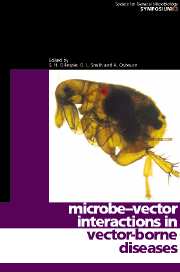Book contents
- Frontmatter
- Contents
- Contributors
- Editors' Preface
- 1 Vector-borne diseases
- 2 Evolution of tick-borne disease systems
- 3 Insect transmission of viruses
- 4 RNA-based immunity in insects
- 5 Specificity of Borrelia–tick vector relationships
- 6 Bunyavirus/mosquito interactions
- 7 How do mosquito vectors live with their viruses?
- 9 Vector competence
- 9 Environmental influences on arbovirus infections and vectors
- 10 Vector immunity
- 11 Transmission of plant viruses by nematodes
- 12 Wolbachia host–symbiont interactions
- 13 Pathogenic strategies of Anaplasma phagocytophilum, a unique bacterium that colonizes neutrophils
- 14 Interactions of Yersinia pestis with its flea vector that lead to the transmission of plague
- 15 Transgenic malaria
- 16 Vaccines targeting vectors
- Index
13 - Pathogenic strategies of Anaplasma phagocytophilum, a unique bacterium that colonizes neutrophils
Published online by Cambridge University Press: 06 July 2010
- Frontmatter
- Contents
- Contributors
- Editors' Preface
- 1 Vector-borne diseases
- 2 Evolution of tick-borne disease systems
- 3 Insect transmission of viruses
- 4 RNA-based immunity in insects
- 5 Specificity of Borrelia–tick vector relationships
- 6 Bunyavirus/mosquito interactions
- 7 How do mosquito vectors live with their viruses?
- 9 Vector competence
- 9 Environmental influences on arbovirus infections and vectors
- 10 Vector immunity
- 11 Transmission of plant viruses by nematodes
- 12 Wolbachia host–symbiont interactions
- 13 Pathogenic strategies of Anaplasma phagocytophilum, a unique bacterium that colonizes neutrophils
- 14 Interactions of Yersinia pestis with its flea vector that lead to the transmission of plague
- 15 Transgenic malaria
- 16 Vaccines targeting vectors
- Index
Summary
INTRODUCTION
Human granulocytic ehrlichiosis (HGE) is an emerging zoonosis caused by Anaplasma phagocytophilum, an obligate intracellular bacterium with a unique tropism for neutrophils (Dumler et al., 2001; Chen et al., 1994). Since documentation of the first human case in 1994, HGE has been increasingly recognized in the United States (US) and Europe. Cases of HGE occur in areas endemic for ticks of the Ixodes persulcatus complex, which are vectors for the disease. In the US, these areas comprise the Northeast, the upper Midwest and northern California (Dumler & Bakken, 1998; Richter et al., 1996; Telford et al., 1996; Pancholi et al., 1995; Chen et al., 1994). Cases of or serological evidence for HGE have been documented in the following European countries – Slovenia, the Netherlands, Sweden, Norway, Spain, Croatia, Poland (Blanco & Oteo, 2002), the Czech Republic (Hulinska et al., 2002), Belgium (Guillaume et al., 2002), Greece (Daniel et al., 2002), Germany (Fingerle et al., 1999), Bulgaria (Christova & Dumler, 1999), Denmark (Lebech et al., 1998) and Switzerland (Pusterla et al., 1998). The annual incidence of HGE in these areas ranges from 2.3 to 16.1 cases per 100 000 persons (McQuiston et al., 1999). In one study, however, 71 of 475 Wisconsin resident serum samples contained antibodies against the HGE agent, which suggests that the annual incidence in this area may be considerably higher (Bakken et al., 1998). In nature, A. phagocytophilum cycles between its tick vector and mammalian hosts, the primary of which are the white-footed mouse, Peromyscus leucopus, and the whitetailed deer, Odocoileus virginianus. Humans are accidental hosts (Dumler & Bakken, 1998; Ogden et al., 1998).
- Type
- Chapter
- Information
- Microbe-vector Interactions in Vector-borne Diseases , pp. 301 - 330Publisher: Cambridge University PressPrint publication year: 2004



